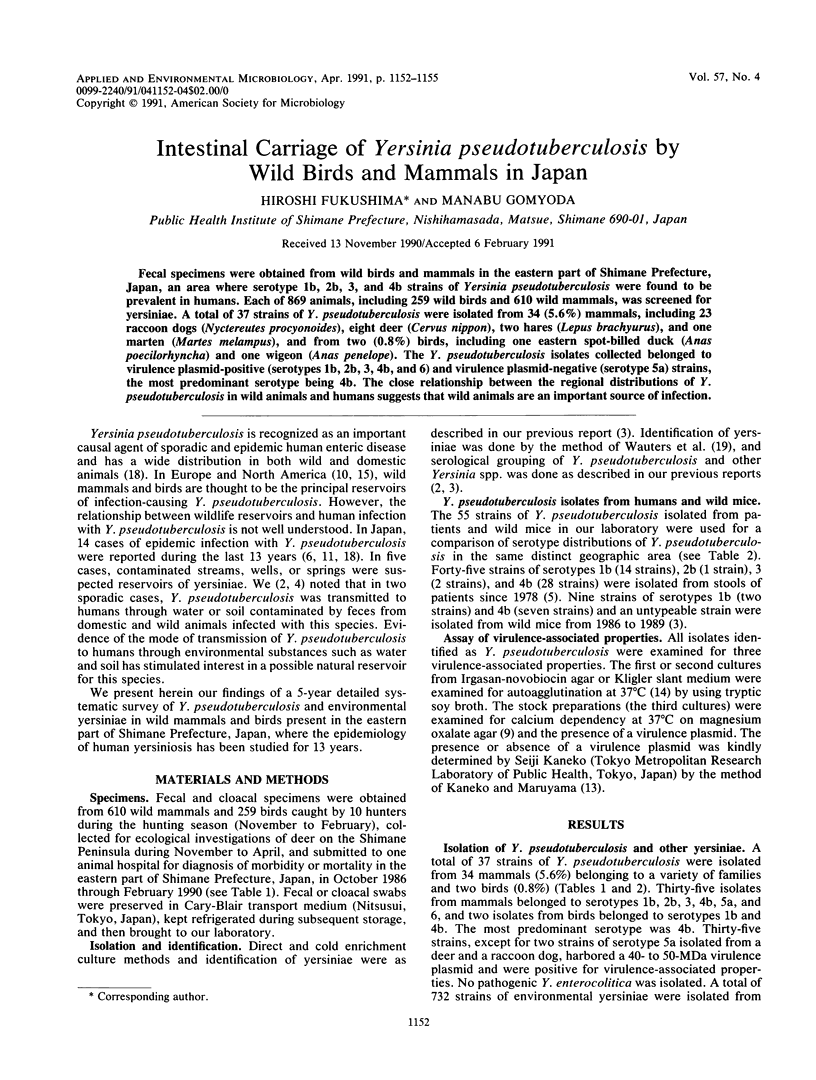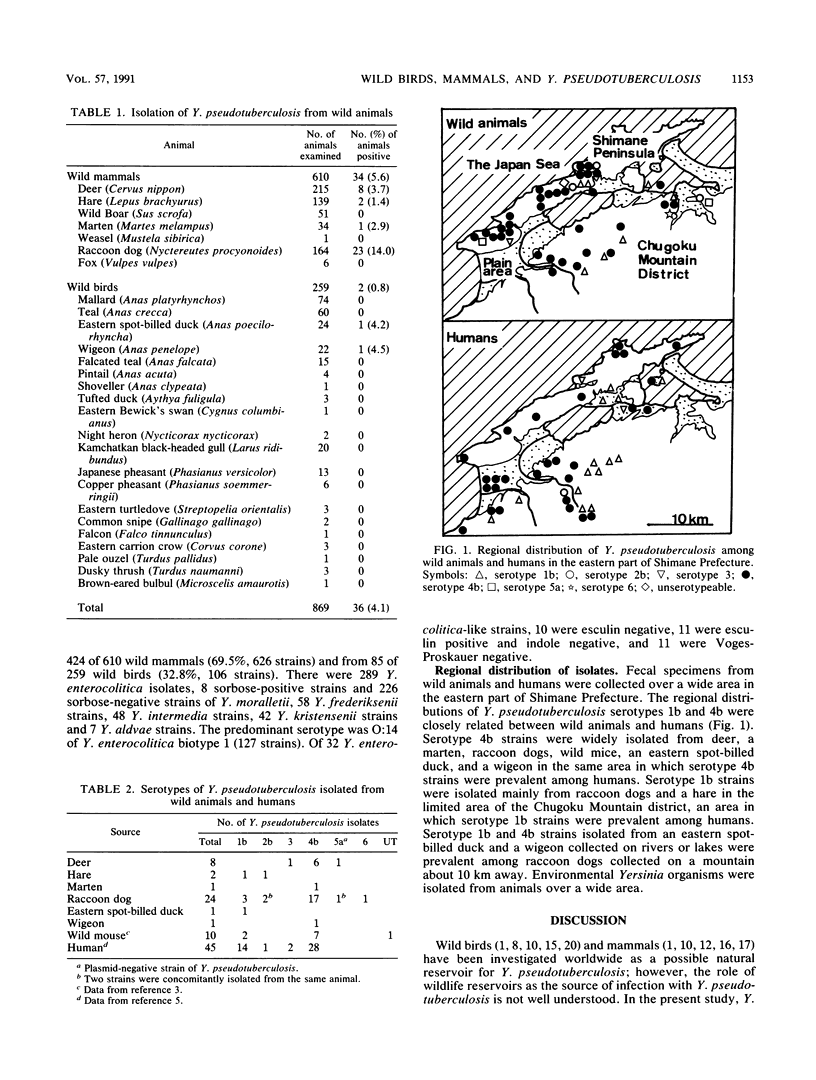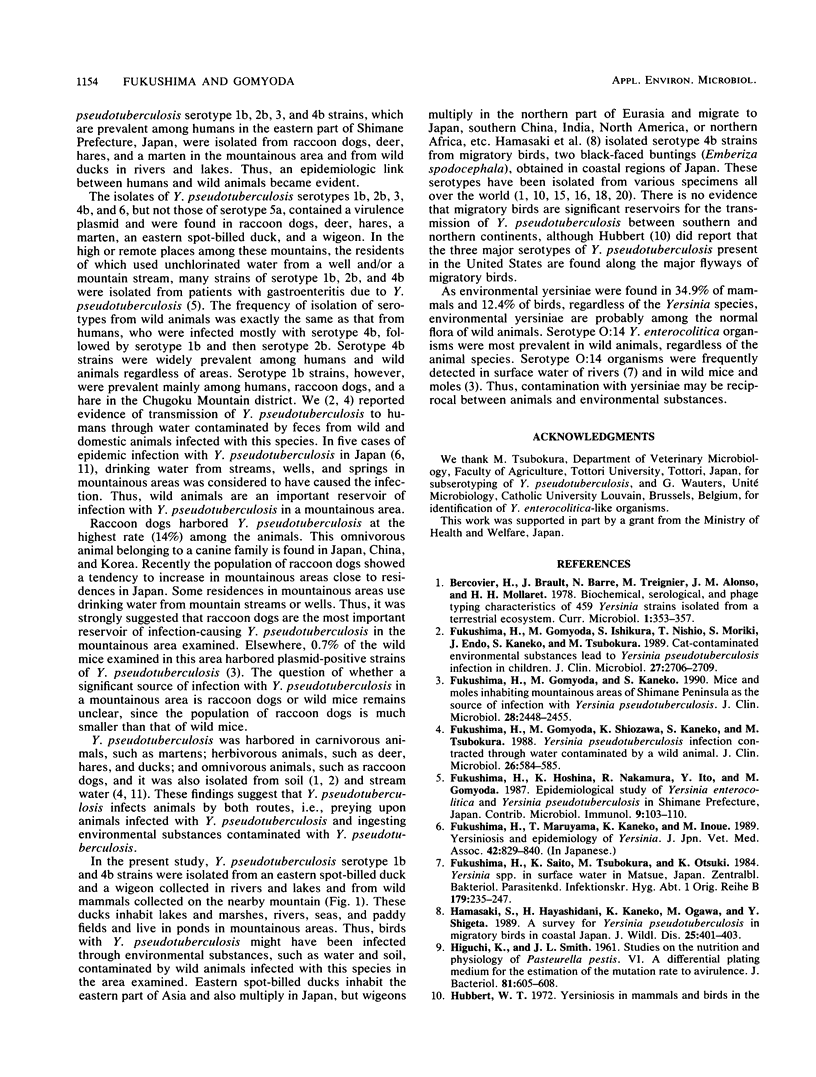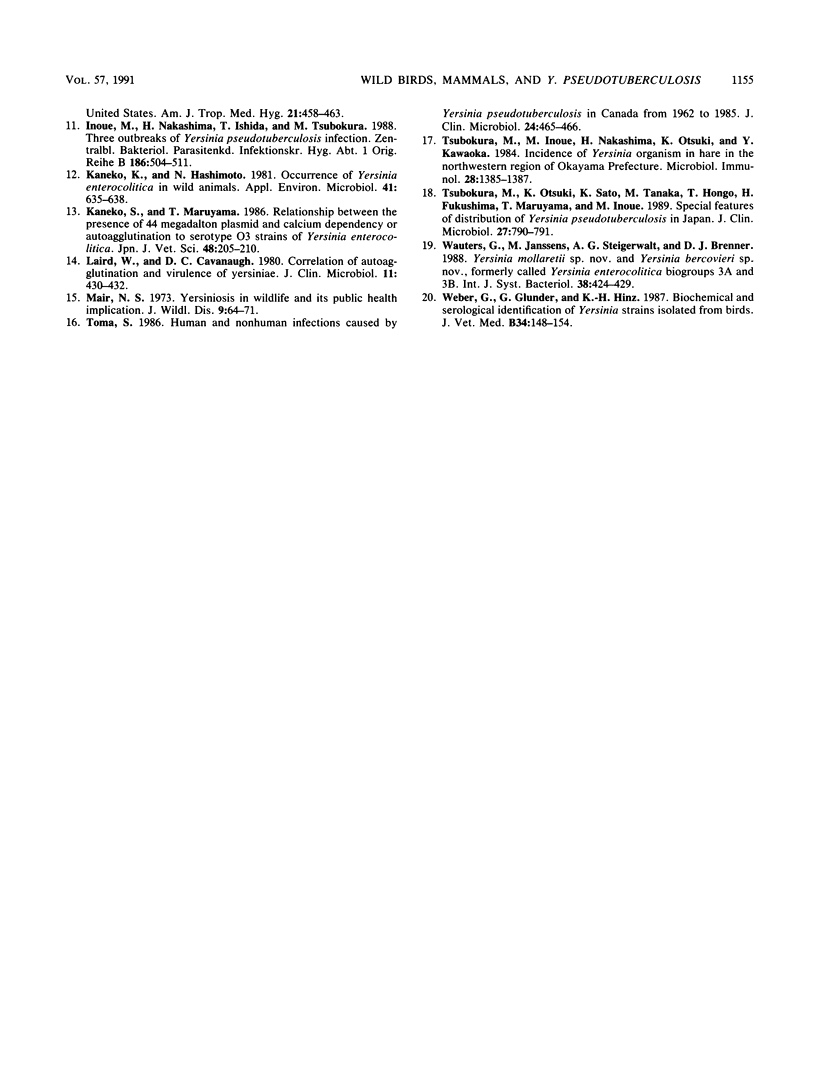Abstract
Fecal specimens were obtained from wild birds and mammals in the eastern part of Shimane Prefecture, Japan, an area where serotype 1b, 2b, 3, and 4b strains of Yersinia pseudotuberculosis were found to be prevalent in humans. Each of 869 animals, including 259 wild birds and 610 wild mammals, was screened for yersiniae. A total of 37 strains of Y. pseudotuberculosis were isolated from 34 (5.6%) mammals, including 23 raccoon dogs (Nyctereutes procyonoides), eight deer (Cervus nippon), two hares (Lepus brachyurus), and one marten (Martes melampus), and from two (0.8%) birds, including one eastern spot-billed duck (Anas poecilorhyncha) and one wigeon (Anas penelope). The Y. pseudotuberculosis isolates collected belonged to virulence plasmid-positive (serotypes 1b, 2b, 3, 4b, and 6) and virulence plasmid-negative (serotype 5a) strains, the most predominant serotype being 4b. The close relationship between the regional distributions of Y. pseudotuberculosis in wild animals and humans suggests that wild animals are an important source of infection.
Full text
PDF



Selected References
These references are in PubMed. This may not be the complete list of references from this article.
- Fukushima H., Gomyoda M., Ishikura S., Nishio T., Moriki S., Endo J., Kaneko S., Tsubokura M. Cat-contaminated environmental substances lead to Yersinia pseudotuberculosis infection in children. J Clin Microbiol. 1989 Dec;27(12):2706–2709. doi: 10.1128/jcm.27.12.2706-2709.1989. [DOI] [PMC free article] [PubMed] [Google Scholar]
- Fukushima H., Gomyoda M., Kaneko S. Mice and moles inhabiting mountainous areas of Shimane Peninsula as sources of infection with Yersinia pseudotuberculosis. J Clin Microbiol. 1990 Nov;28(11):2448–2455. doi: 10.1128/jcm.28.11.2448-2455.1990. [DOI] [PMC free article] [PubMed] [Google Scholar]
- Fukushima H., Gomyoda M., Shiozawa K., Kaneko S., Tsubokura M. Yersinia pseudotuberculosis infection contracted through water contaminated by a wild animal. J Clin Microbiol. 1988 Mar;26(3):584–585. doi: 10.1128/jcm.26.3.584-585.1988. [DOI] [PMC free article] [PubMed] [Google Scholar]
- Fukushima H., Hoshina K., Nakamura R., Ito Y., Gomyoda M. Epidemiological study of Yersinia enterocolitica and Yersinia pseudotuberculosis in Shimane Prefecture, Japan. Contrib Microbiol Immunol. 1987;9:103–110. [PubMed] [Google Scholar]
- Fukushima H., Saito K., Tsubokura M., Otsuki K. Yersinia spp. in surface water in Matsue, Japan. Zentralbl Bakteriol Mikrobiol Hyg B. 1984 Jun;179(3):236–247. [PubMed] [Google Scholar]
- HIGUCHI K., SMITH J. L. Studies on the nutrition and physiology of Pasteurella pestis. VI. A differential plating medium for the estimation of the mutation rate to avirulence. J Bacteriol. 1961 Apr;81:605–608. doi: 10.1128/jb.81.4.605-608.1961. [DOI] [PMC free article] [PubMed] [Google Scholar]
- Hamasaki S., Hayashidani H., Kaneko K., Ogawa M., Shigeta Y. A survey for Yersinia pseudotuberculosis in migratory birds in coastal Japan. J Wildl Dis. 1989 Jul;25(3):401–403. doi: 10.7589/0090-3558-25.3.401. [DOI] [PubMed] [Google Scholar]
- Hubbert W. T. Yersiniosis in mammals and birds in the United States: case reports and review. Am J Trop Med Hyg. 1972 Jul;21(4):458–463. doi: 10.4269/ajtmh.1972.21.458. [DOI] [PubMed] [Google Scholar]
- Inoue M., Nakashima H., Ishida T., Tsubokura M. Three outbreaks of yersinia pseudotuberculosis infection. Zentralbl Bakteriol Mikrobiol Hyg B. 1988 Aug;186(5-6):504–511. [PubMed] [Google Scholar]
- Kaneko K., Hashimoto N. Occurrence of Yersinia enterocolitica in wild animals. Appl Environ Microbiol. 1981 Mar;41(3):635–638. doi: 10.1128/aem.41.3.635-638.1981. [DOI] [PMC free article] [PubMed] [Google Scholar]
- Kaneko S., Maruyama T. Relationship between the presence of 44 megadalton plasmid and calcium dependency or autoagglutination to serotype O3 strains of Yersinia enterocolitica. Nihon Juigaku Zasshi. 1986 Apr;48(2):205–210. doi: 10.1292/jvms1939.48.205. [DOI] [PubMed] [Google Scholar]
- Laird W. J., Cavanaugh D. C. Correlation of autoagglutination and virulence of yersiniae. J Clin Microbiol. 1980 Apr;11(4):430–432. doi: 10.1128/jcm.11.4.430-432.1980. [DOI] [PMC free article] [PubMed] [Google Scholar]
- Mair N. S. Yersiniosis in wildlife and its public health implications. J Wildl Dis. 1973 Jan;9(1):64–71. doi: 10.7589/0090-3558-9.1.64. [DOI] [PubMed] [Google Scholar]
- Toma S. Human and nonhuman infections caused by Yersinia pseudotuberculosis in Canada from 1962 to 1985. J Clin Microbiol. 1986 Sep;24(3):465–466. doi: 10.1128/jcm.24.3.465-466.1986. [DOI] [PMC free article] [PubMed] [Google Scholar]
- Tsubokura M., Inoue M., Nakashima H., Otsuki K., Kawaoka Y. Incidence of Yersinia organism in hare in the northwestern region of Okayama Prefecture. Microbiol Immunol. 1984;28(12):1385–1387. doi: 10.1111/j.1348-0421.1984.tb00796.x. [DOI] [PubMed] [Google Scholar]
- Tsubokura M., Otsuki K., Sato K., Tanaka M., Hongo T., Fukushima H., Maruyama T., Inoue M. Special features of distribution of Yersinia pseudotuberculosis in Japan. J Clin Microbiol. 1989 Apr;27(4):790–791. doi: 10.1128/jcm.27.4.790-791.1989. [DOI] [PMC free article] [PubMed] [Google Scholar]


